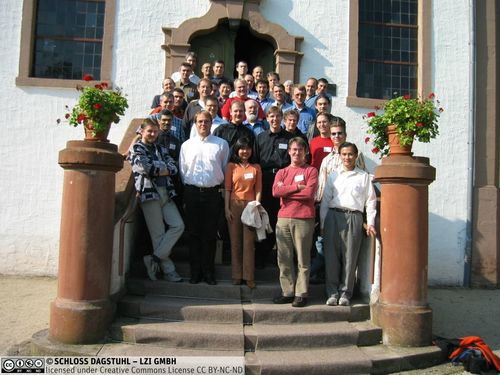Dagstuhl-Seminar 04411
Service Management and Self-Organization in IP-based Networks
( 03. Oct – 06. Oct, 2004 )
Permalink
Organisatoren
- Matthias Bossardt (ETH Zürich, CH)
- Georg Carle (Universität Tübingen, DE)
- Hermann de Meer (Universität Passau, DE)
- David Hutchison (Lancaster University, GB)
- Bernhard Plattner (ETH Zürich, CH)
Kontakt
Ad-hoc, peer-to-peer, pervasive, active and programmable networks are emerging research disciplines that pave the way to provision network users with innovative services. However, it turns out that the management of such services is complex, tedious and error-prone. Therefore, applying self-organizing techniques to automate service management and to reduce human intervention is expected to lead to better manageable and more robust network architectures. Hence, the goal of the Dagstuhl Seminar on Service Management and Self-Organization in IP-based Networks has been to identify open questions and to discuss new ideas in this exciting research field. These seminar proceedings contain several extended abstracts written by seminar participants, which are briefly introduced in the following sections. Moreover, the slides of many seminar talks can be found at http://www.dagstuhl.de/04411/Materials.
Self-organizing techniques often use local decision-making to achieve a global goal . The paper by De Meer discusses self-organizing properties of peer-to-peer networks. Network nodes take local decisions based on information received from the network. Papers by Yamamoto and Babaoglu describe mechanisms to distribute information among nodes using gossip- or epidemic dissemination-based approaches. Ripeanu describes an approach to adapt overlay topologies to the state of the underlying network. Papers by Chen, Schulzrinne and Tutschku present network services that adapt to network state (e.g. congestion). Babaoglu presents an interesting example showing how a gossip-based approach can be used to impose a specific network topology. However, it remains an open issue to a priori define the details of the local decision taking process such that it results in a predetermined global outcome.
In nature, many self-organizing systems can be observed and are studied by scientists. Hence, the results of such studies may help engineers to build self-organizing techniques into technical systems. In fact, engineers have developed bio-inspired algorithms that mimic the behavior of biological systems to solve a variety of problems. Dressler intends to secure networks using an architecture directly derived from cell and molecular biology. Tschudin proposes a method to implement self-healing communication protocols. While Dressler suggests a technical system mimicking nature as closely as possible, Tschudin’s approach is rather inspired by the resulting behavior of biological systems. Considering these approaches that mark two opposite points in the design space of bio-inspired systems, it is not yet fully understood to what extent technical approaches should mimic biological systems in order to achieve optimal results.
The different flavors of self-organizing techniques presented above aim at simplifying the management of networks. The question arises, which are the primitives, knobs and dials that network architectures should offer to support their implementation. Sterbenz discusses where knobs and dials should be placed. Papers by Calvert, Hjlmtýsson, Wehrle and Sifalakis describe network architectures providing new primitives that simplify the implementation of new functionality within the network. Approaches described by Brunner, Farkas, and Minden aim at providing tools and mechanisms to dynamically deploy new functionality in networks, while the paper by Ruf presents a flexible platform to efficiently execute such functionality. Finally, papers by Gao and Gerke describe economical aspects of service management in new network architectures.
The Dagstuhl Seminar brought together 38 researchers and engineers from Australia, USA and Europe. Their different background and numerous presentations resulted in interesting discussions. The organizers are very grateful to all the participants for actively participating, raising questions and providing new insights. We would like to thank James Sterbenz for supporting us during the conference and the Dagstuhl Association for providing our research community with an excellent venue for scientific exchange.
The organizers:
- Matthias Bossardt (ETH Zürich), Editor
- Georg Carle (Univ, Tübingen)
- David Hutchison (Lancaster Univ.)
- Hermann de Meer (Univ. Passau)
- Bernhard Plattner (ETH Zürich)
- Ozalp Babaoglu (University of Bologna, IT)
- Ernst Biersack (EURECOM - Biot, FR) [dblp]
- Matthias Bossardt (ETH Zürich, CH)
- Marcus Brunner (NEC Laboratories Europe - Heidelberg, DE) [dblp]
- Kenneth L. Calvert (University of Kentucky, US) [dblp]
- Roberto Canonico (University of Naples, IT)
- Georg Carle (Universität Tübingen, DE) [dblp]
- Ken Chen (University of Paris-Nord, FR)
- Hermann de Meer (Universität Passau, DE) [dblp]
- Falko Dressler (Universität Erlangen-Nürnberg, DE) [dblp]
- Karoly Farkas (ETH Zürich, CH)
- Michael Fry (University of Sydney, AU)
- Thomas Fuhrmann (KIT - Karlsruher Institut für Technologie, DE) [dblp]
- Raymond Gao (P2P Journal - Garland, US)
- Jan Gerke (ETH Zürich, CH)
- Jane Hall (Fraunhofer FOKUS - Berlin, DE)
- Oliver Heckmann (TU Darmstadt, DE)
- Gisli Hjálmtysson (Reykjavik University, IS)
- Mohan Kumar (University of Texas at Arlington, US)
- Vincent Lenders (ETH Zürich, CH) [dblp]
- Laurent Mathy (Lancaster University, GB) [dblp]
- Andreas Mauthe (Lancaster University, GB) [dblp]
- Martin May (ETH Zürich, CH)
- Gary Minden (University of Kansas - Lawrence, US)
- Bernhard Plattner (ETH Zürich, CH)
- Wolfgang Reichert (IBM Deutschland - Böblingen, DE)
- Bernd Reuther (TU Kaiserslautern, DE)
- Matei Ripeanu (University of Chicago, US) [dblp]
- Lukas Ruf (ETH Zürich, CH)
- Henning Schulzrinne (Columbia University - New York, US) [dblp]
- Manolis Sifalakis (Lancaster University, GB)
- James P. G. Sterbenz (University of Kansas - Lawrence, US) [dblp]
- Burkhard Stiller (Universität Zürich, CH) [dblp]
- Christian Tschudin (Universität Basel, CH) [dblp]
- Kurt Tutschku (Universität Würzburg, DE) [dblp]
- Ian Wakeman (University of Sussex - Brighton, GB)
- Klaus Wehrle (Universität Tübingen, DE) [dblp]
- Lidia Yamamoto (Universität Basel, CH)


